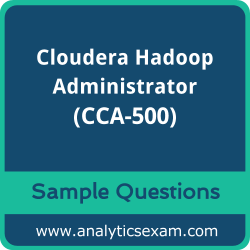 Here are the sample questions which will help you be familiar with Cloudera Certified Administrator for Apache Hadoop (CCAH) exam style and structure. We encourage you to try our Demo Cloudera Hadoop Administrator Certification Practice Exam to measure your understanding of exam structure in an environment which simulates the Cloudera Certified Apache Hadoop Administrator (CCA-500) Certification test environment.
Here are the sample questions which will help you be familiar with Cloudera Certified Administrator for Apache Hadoop (CCAH) exam style and structure. We encourage you to try our Demo Cloudera Hadoop Administrator Certification Practice Exam to measure your understanding of exam structure in an environment which simulates the Cloudera Certified Apache Hadoop Administrator (CCA-500) Certification test environment.
To make your preparation more easy for Cloudera Certified Apache Hadoop Administrator (CCA-500) exam, we strongly recommend you to use our Premium Cloudera Hadoop Administrator Certification Practice Exam. According to our survey with certified candidates, you can easily score 85% in your actual Cloudera Certification exam if you can score 100% in our premium Cloudera Hadoop Administrator Certification practice exams.
Cloudera CCA-500 Sample Questions:
Question 1: You’re upgrading a Hadoop cluster from HDFS and MapReduce version 1 (MRv1) to one running HDFS and MapReduce version 2 (MRv2) on YARN.
You want to set and enforce version 1 (MRv1) to one running HDFS and MapReduce version 2 (MRv2) on YARN.
You want to set and enforce a block size of 128MB for all new files written to the cluster after upgrade. What should you do?
A. You cannot enforce this, since client code can always override this value
B. Set dfs.block.size to 134217728 on all the worker nodes, on all client machines, and on the NameNode, and set the parameter to final
C. Set dfs.block.size to 128 M on all the worker nodes and client machines, and set the parameter to final. You do not need to set this value on the NameNode
D. Set dfs.block.size to 134217728 on all the worker nodes and client machines, and set the parameter to final. You do not need to set this value on the NameNode
E. Set dfs.block.size to 128M on all the worker nodes, on all client machines, and on the NameNode, and set the parameter to final
Question 2: Your Hadoop cluster is configuring with HDFS and MapReduce version 2 (MRv2) on YARN. Can you configure a worker node to run a NodeManager daemon but not a DataNode daemon and still have a functional cluster?
A. Yes. The daemon will receive Reducer tasks only
B. Yes. The daemon will receive Map tasks only
C. Yes. The daemon will get data from another (non-local) DataNode to run Map tasks
D. Yes. The daemon will receive data from the NameNode to run Map tasks
Question 3: Your Hadoop cluster contains nodes in three racks. You have not configured the dfs.hosts property in the NameNode’s configuration file. What results?
A. The NameNode will update the dfs.hosts property to include machines running the DataNode daemon on the next NameNode reboot or with the command dfsadmin –refreshNodes
B. Presented with a blank dfs.hosts property, the NameNode will permit DataNodes specified in mapred.hosts to join the cluster
C. No new nodes can be added to the cluster until you specify them in the dfs.hosts file
D. Any machine running the DataNode daemon can immediately join the cluster
Question 4: Your company stores user profile records in an OLTP databases. You want to join these records with web server logs you have already ingested into the Hadoop file system. What is the best way to obtain and ingest these user records?
A. Ingest using Hive’s IQAD DATA command
B. Ingest with Hadoop streaming
C. Ingest with Pig’s LOAD command
D. Ingest using the HDFS put command
E. Ingest with sqoop import
Question 5: Your cluster’s mapred-start.xml includes the following parameters
<name>mapreduce.map.memory.mb</name>
<value>4096</value>
<name>mapreduce.reduce.memory.mb</name>
<value>8192</value>
And any cluster’s yarn-site.xml includes the following parameters
<name>yarn.nodemanager.vmen-pmen-ration</name>
<value>2.1</value>
What is the maximum amount of virtual memory allocated for each map task before YARN will kill its Container?
A. 24.6 GB
B. 8.9GB
C. 17.2 GB
D. 4 GB
E. 8.2 GB
Question 6: Your cluster is running MapReduce version 2 (MRv2) on YARN. Your ResourceManager is configured to use the FairScheduler.
Now you want to configure your scheduler such that a new user on the cluster can submit jobs into their own queue application submission. Which configuration should you set?
A. You can specify new queue name when user submits a job and new queue can be created dynamically if yarn .schedule.fair.user-as-default-queue = false
B. You can specify new queue name per application in allocations.xml file and have new jobs automatically assigned to the application queue
C. Yarn.scheduler.fair.user.fair-as-default-queue = false and yarn.scheduler.fair.allowundecleared- pools = true
D. You can specify new queue name when user submits a job and new queue can be created dynamically if the property yarn.scheduler.fair.allow-undecleared-pools = true
Answers:
|
Question: 1 |
Answer:C |
Question: 2 |
Answer:C |
|
Question: 3 |
Answer:D |
Question: 4 |
Answer:E |
|
Question: 5 |
Answer:E |
Question: 6 |
Answer:D |
Note: Please write us on feedback@analyticsexam.com if you find any data entry error in these Cloudera Certified Apache Hadoop Administrator (CCA-500) sample questions.
 Here are the sample questions which will help you be familiar with Cloudera Certified Administrator for Apache Hadoop (CCAH) exam style and structure. We encourage you to try our Demo Cloudera Hadoop Administrator Certification Practice Exam to measure your understanding of exam structure in an environment which simulates the Cloudera Certified Apache Hadoop Administrator (CCA-500) Certification test environment.
Here are the sample questions which will help you be familiar with Cloudera Certified Administrator for Apache Hadoop (CCAH) exam style and structure. We encourage you to try our Demo Cloudera Hadoop Administrator Certification Practice Exam to measure your understanding of exam structure in an environment which simulates the Cloudera Certified Apache Hadoop Administrator (CCA-500) Certification test environment.